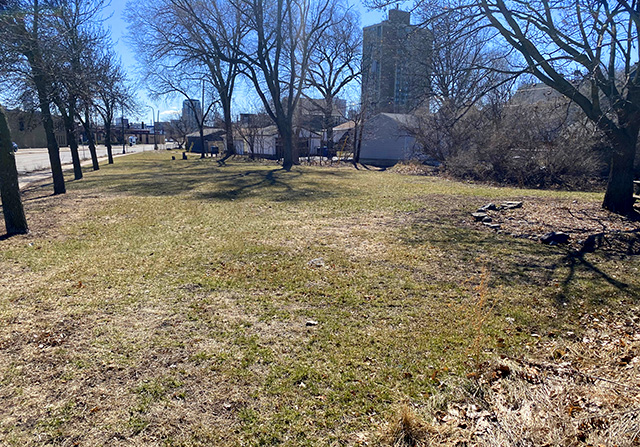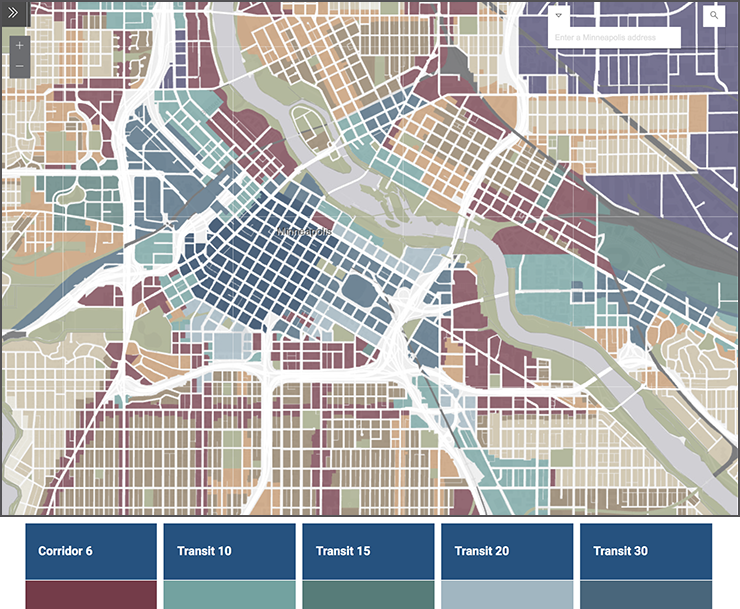Low-carbon construction: check
Passive low-energy design: check
Right next to a planned major transit stop: check
Mid-scale “missing middle” housing: check
Deluxe bicycling facilities instead of off-street parking: check
A recent proposal for a Northeast apartment building seems tailor-made for the Minneapolis 2040 Comprehensive Plan, which passed with pomp and circumstance by a 12-1 City Council vote in 2019. At the time, the plan codified ambitious citywide goals around housing, equity, transportation and climate action, in part by making big steps to encourage density and investment throughout the city.
So it was a big deal last month when an apartment proposal by a local, small-scale developer hit a wall. In a rare case where commissioners overturned staff recommendations, the Minneapolis Planning Commission voted 6-3 to deny the application. The case is going to the Minneapolis City Council’s Business, Inspections, Housing, & Zoning Committee for a decision next Tuesday, with another public hearing scheduled.
Combining affordable housing with climate action
Cody Fischer, a self-described “building science” nerd, became interested in housing as he grew frustrated by the lack of options in much of Minneapolis. As a result, two years ago Fischer built an unusual six-plex behind a duplex he owned in South Minneapolis, one of the most innovative infill projects I’ve seen. The Van Buren proposal is his next investment idea: a 23-unit apartment building on a single-lot right next to NE Central Avenue.

Fischer’s four-story building proposal will offer a mix of studio and one-bedroom apartments in the heart of Northeast Minneapolis. The area certainly has a housing shortage, with high demand for apartments in between the towers of Central-Hennepin and the popular Northeast Minneapolis Arts District.
“It’s a 60-foot-wide lot at Van Buren with alley access, and [the city’s] Corridor 6 overlay was ideal,” Fischer told me, referring to the Minneapolis 2040 zoning changes that allows for six-story development on the parcel. “And it’s obviously a spectacular location from a transit, commerce, amenities and jobs perspective.”
For climate action, the bells and whistles on the building are something that I’ve not seen this side of a European architecture studio. The building incorporates high R60 insulation standards, solar heat gain capture, and what Fischer describes as “minimal continuous thermal envelope,” which I had to look up. The end result is what Fischer hopes will be a model for how to combine affordable housing with climate action.
“It will be fully electrified and solar powered, 60% more energy efficient than anything built today, with low embodied carbon,” Fischer told me. “With 40% of carbon emissions globally coming from buildings, the next decade is critical for the planet. What we build, how we build and where we build will be decisive about whether we avoid the worse impacts of climate change.”
The character of the neighborhood
Admittedly the site is a bit unusual. The apartments would abut an alley running between NE Van Buren Street and vacant land along busy Central Avenue, one of Minneapolis main drags. The street’s #10 bus is one of Minneapolis highest ridership routes, and is slated for a multimillion-dollar service upgrade with the Metro Transit F Line project in 2025. Within two years, people living in the new building will have some of the best transit service in the state.
But that all depends on city approval, which is in limbo as two dozen neighbors from in and around Van Buren Street called into the Planning Commission with objections to the apartments. The main complaints were traffic, parking, shadows, and concerns over the process around the 2040 Plan zoning changes.

The “character of the neighborhood” is not just a frequent topic at community meetings, but is often part of the findings written into city zoning codes. At the same time, neighborhood character is always in the eye of the beholder.
For example, within two blocks of the Van Buren property you find: a 50-year-old, 20-story public housing tower; Lush, a former warehouse converted into a thriving gay bar; windowless industrial uses like an electronic recycling plant and a seed supply warehouse; and the Vegas Lounge, Minneapolis’ best karaoke dive. Meanwhile, there are duplexes and a four-unit apartment building just a few doors down on Van Buren Street. If anything this site illustrates the rich diversity and density of Northeast Minneapolis.
Still, the testimony convinced a few commissioners to change their minds, even though the ensuing debate over the staff report centered on things outside the zoning code like parking or contested driveway access. As a result, what should have been a perfunctory plan application was rejected. Third Ward Council Member Michael Rainville, who represents the area, made the motion, calling the plan “just not a good project” and stating that the applicant had “not been very neighborly.”
I reached out to Rainville for this story, but he said he is unable to comment due to the quasi-judicial nature of this kind of case.
Setting a precedent for 2040 changes
The Van Buren impasse calls into question the ambitious upcoming overlays that are a key part of the Minneapolis 2040 plan. One of the middle-ground zoning changes, Corridor 6 zoning, is sprinkled all over Minneapolis’ commercial streets: along the North Minneapolis riverfront, West Broadway, Hennepin, Lyndale and Nicollet in South Minneapolis, and a dozen other key transit routes. In theory, any property along those streets can “by right” be developed into a multi-story apartment building. In practice, this decision from the City Council will set a precedent for all those communities going forward.
The stakes are high, because a recent study by the Denver-based climate think tank RMI analyzed local actions that cities can take, and found that urban infill is the single most effective kind of climate action. Focusing on the specific number of trees, while ignoring the density and impacts of new energy-efficient housing next to transit, is a recipe for climate inaction.
At the very least, Cody Fischer will probably have a good lawsuit on his hands, but what he really wants to do is see more apartments built next to transit in Minneapolis.
“For me what I was trying to build is an urban cyclists, pet-lovers paradise for people that want transit, a bike-oriented lifestyle, and to live with a low carbon footprint,” Fischer told me. “We’d take that story, and show everyone in our market that you can do that exact same thing. It’s an up-front cost premium, but it reduces maintenance and utility costs in the long-term. That’s my vision for it. “


0 Commentaires